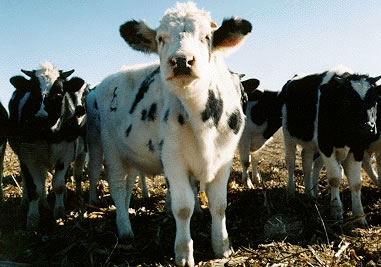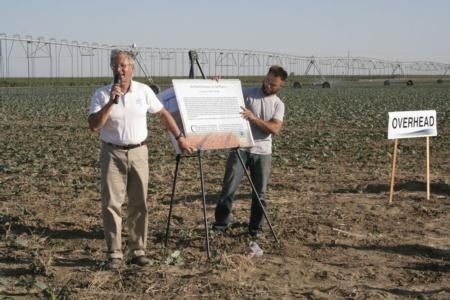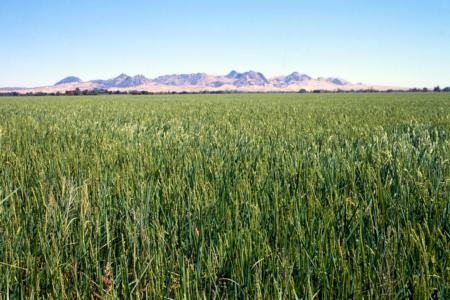Posts Tagged: greenhouse gas
San Joaquin Valley row crop growers help control greenhouse gases
Taylor interviewed lead researcher Jeff Mitchell, UC ANR Cooperative Extension specialist and chair of the UC ANR Conservation Agriculture Systems Innovation Center.
Long-term research by UC ANR has documented the capacity for farmland in the San Joaquin Valley managed with certain conservation practices to sequester carbon, results that could give farmers a seat at the carbon trading table, the article said. The study was published this month in the Agronomy Journal.
"We're reducing the atmospheric load of carbon dioxide, a greenhouse gas that plays an important role in global warming," Mitchell said. "Proving a stable storage location for carbon could allow agriculture to be part of future cap-and-trade programs."
The ANR news release on the research was also picked up by the Central Valley Business Times, California Political Review and the Red Bluff Daily News.
Click here to listen to Doug Cooper of AgLife radio interview Mitchell about the research.
California rice growers reduce greenhouse gas emissions
Butler is participating in a pilot program funded by the Environmental Defense Fund. Though it’s too early to measure, he has seen promising signs from the project.
“We’ve had good results with yield and water conservation, which really was our goal,” says Butler. “We’re happy that greenhouse gases go down as a result of that, but they weren’t the initial reason why we do that.”
Of the global GHG accumulation for all sectors, 0.001 percent comes from California rice fields, according to data compiled by Luis Espino, UC Cooperative Extension rice farm advisor for Colusa County.
“It’s such a new issue I don’t think much has been done in that area,” says Espino. “Right now UC Davis is doing the research, doing the modeling, trying to understand what goes on in the soil.”
Cass Mutters, UC Cooperative Extension advisor for Butte County, noted that California rice growers realize that being environmentally sensitive is part of their responsibility. Since the 1980s, changes in irrigation management and other practices have led to a 98 percent reduction in pesticide residues entering public waterways from rice fields. Along with water quality, the rice industry supports an air quality monitoring network that enables the Air Resources Board to model how many acres can be burned without exceeding federal air quality standards.
Kaffka, partners awarded $2 million to develop biofuel
The Biodiesel Industries of Ventura was awarded $2 million grant for research and development of biodiesel fuel, according to a report by Marjorie Hernandez of the Ventura County Star.
Biodiesel Industries has partnered with Stephen Kaffka, director of the California Biomass Collaborative and UC Cooperative Extension specialist in the Department of Plant Sciences at UC Davis.
Kaffka will conduct research to develop viable biofuel feedstocks at test plots at UC Davis and in Salinas, the Imperial Valley and Five Points in the Central Valley, according to the article.
Biodico President Russell Teall said, "The goal is to develop innovative solar cogeneration, anaerobic digestion and gasification. While Dr. Kaffka will look at the agronomics, Diener will take those results and use them in a larger context. We will be able to take biomass, which can be gasified and used to make heat and power that will provide a very clean form of combustion."
Teall said the project should start in June, with various equipment in place by August or September.
Pollution regulations stymie dairy electricity generation
For Central Valley dairies, conflicting laws are making it hard to generate green electricity from dairy waste, according to an article this week in the Los Angeles Times.
In order to reduce emissions of methane - a greenhouse gas - some dairy operators have installed methane digesters that convert the methane into electricity.
However, the process produces nitrogen oxides (NOx), which react with volatile organic compounds to create ozone, a significant air pollution problem in the San Joaquin Valley. NOx levels for the valley, a region with air pollution among the most severe in the country, is set by federal officials and enforced by the San Joaquin Valley Air Pollution Control District.
The district is requiring expensive modifications on digesters, which in some cases shuts the equipment down altogether. Air district officials told the LA Times they're just doing their jobs. "Combating smog, not climate change, is the agency's mission," Times reporter P.J. Huffstutter wrote.
Modesto dairy operator John Fiscalini spent hundreds of thousands of dollars on a catalytic converter and other filtering equipment to meet the air district's limit of 11 parts per million of NOx for his digester system.UC Davis Cooperative Extension animal scientist Frank Mitloehner told the Times that works out to equal the emissions of 26 cars for every 1,000 cows.
"They have a point. I want clean air," Visalia dairy farmer Ron Koetsier was quoted in the story. "But it doesn't make financial sense for me keep doing this. I don't see how they can turn methane gas into electricity in California, given these rules."

Dairy cow in California.
UC helps Marin dairy operators clear the air
UC Cooperative Extension provided Marin ranchers and dairy operators exposure at a two-hour workshop Feb. 2 to the latest conservation practices that can help the agriculture industry reduce its environmental impacts and increase farm and ranch energy efficiency.
In addition to local farmers, reporter Rob Rogers was at the event collecting information for an article published in the Marin Independent Journal yesterday.Rogers reported that cows produce a smaller percentage of greenhouse gases in the United States and Europe than in other nations, where farming is a larger part of the economy, and where it's practiced less efficiently. According to the United Nations, livestock produce about 18 percent of the world's greenhouse gasses. In the U.S., livestock is responsible for just 5.8 percent of total greenhouse gas emissions.
Workshop speaker Frank Mitloehner, UC Davis air quality specialist, said research shows that it is cows - not waste storage lagoons - that emit most methane and nitrous oxide on dairies.
"Lagoon waste is so heavily diluted that it's a smaller factor than fresh waste," Mitloehner was quoted in the story.
He offered solutions that may not sit well with organic producers:
-
Produce more milk with fewer cows by increasing efficiency.
-
Cut back on grass-fed cattle, which, because of extra roughage, produce more methane.
Albert Strauss, an organic dairy farmer who also spoke at the meeting, noted that reducing cow emissions is only part of the environmental picture. One option for reducing dairy emissions is converting waste into energy with a methane digester. Using this technology, the Strauss operation meets its own energy needs and will soon be selling extra energy back to PG&E, the article said.

dairycow



